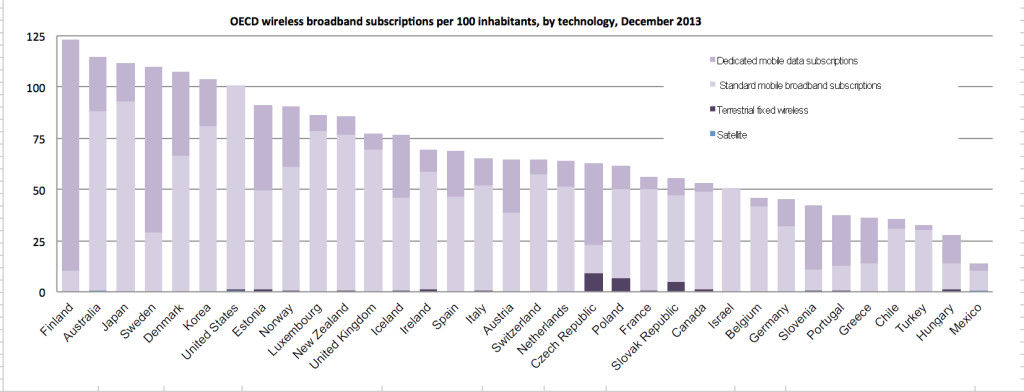The OECD released its latest Internet broadband data yesterday, covering the 34 OECD member states. The update emphasized wireless broadband access, comparing subscription rates across the OECD (many other aspects of the OECD data collection, including pricing and speeds, were not updated). Wireless broadband has emerged in recent years as a critical method of Internet connectivity with consumers and businesses relying on mobile broadband, yet the OECD data has Canada ranking poorly for wireless broadband subscriptions when compared to the rest of the developed economy world (coverage from the Wire Report (sub req)). The OECD release comes one week after a CRTC sponsored report found that Canadian wireless pricing is among the most expensive in the G7 in every tier of usage.
Seven countries, including Finland, Australia, Japan, Sweden, Denmark, Korea, and the U.S., have at least one subscription for every inhabitant. In Canada, the number drops to 53.3 subscriptions for every 100 inhabitants. That places Canada 24th out of 34 OECD countries.
Canada’s major wireless providers insist that speeds and pricing are competitive with the rest of the world, yet the data confirms that there are far fewer mobile broadband subscriptions in Canada when compared to other OECD countries. Policy makers and regulators must be asking why the numbers are much lower in Canada. Canada ranks higher for fixed broadband (ie. cable or DSL) at 11th in the OECD, but virtually all the countries ahead of it also rank ahead on wireless, so it is not simply a case of consumers replacing fixed with wireless services. Further, countries such as Japan and South Korea rank toward the top of the wireless broadband chart, so multiple subscriptions to overcome roaming costs do not explain the differences. Is it a function of pricing? Different access plans or tethering? Different usage of devices? The consistently poor rank – Canada has been in the bottom third of the OECD on wireless broadband subscriptions for years – requires some answers.









And cue the Big Media apologists to tell us that it’s this way because Canada is big and has mountains and lakes and birds & bees, so naturally our Internet is crappy and expensive.
Word, it’s the same excuse every time something like this comes out. We are too big and too sparse to have any competition in this country.
Roughly one third of Canadians live in rural parts of the country where wireless data coverage is more limited so it makes sense that these folks aren’t going to buy something they can’t use. Most wireless data coverage is provided on high band carriers like 1900 and 2100 MHz which have much shorter range and are more easily blocked by trees and geographic features.
As the telcos start to deploy the new 700 MHz spectrum (for data) it is reasonable to assume that data subscriptions amongst these folks will increase. But the telcos are going to have their hands full trying to convince this market segment to replace their old flip phones with smartphones.
According to the OECD’s historical charts, Canada went from less than 1% wireless broadband penetration in 2009 to over 50% in December 2013. The OECD average increase in % connected over that period was just under 40%. Australia’s was over 100%. If what’s being measured is meaningful, then the increases are astounding.
Methodologically, are “share plans” with multiple devices counted as a single subscription or as multiple subscriptions?
Interpretation wise, are multiple devices that do different things and are on individual plans driving the greater than 100% adoption rates in top countries, or are the greater than 100% rates coming from people carrying multiple cellphones (work+personal) or multiple subscriptions (eg, for roaming) driving the greater than 100% adoption rates? Only the first of these is really indicating greater adoption of wireless services because of the value they offer.
The methodology of counting subscribers is lifted from the wireline survey of subscribers. Here a subscriber and a household are pretty closely related. Canada has consistently performed well here, and continues to.
Pingback: New OECD Releases New Broadband Data: Canada Ranks in Bottom Third on Mobile Broadband Subscriptions – Stephen's Lighthouse